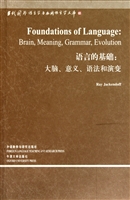语言的基础--大脑意义语法和演变
标 签:语言学 语言文字 语言.文字
《语言的基础——大脑、意义、语法和演变》是Jackendoff多年来有关语言理论基础和理论研究模式的集大成。
《语言的基础——大脑、意义、语法和演变》是有关语言的理论基础和理论研究模式的集大成之作,融汇了心理学、神经科学、生物学、哲学以及生物进化论等相关研究领域的成果,在评价乔姆斯基关于普遍语法的种种观点之余.提出了语言处理的平行构架观作为人脑存储和处理语言的基本理论框架,为我们理解语言和交际,尤其是认识语法、词汇、语言习得、语言的起源以及语言和思维与真实世界的关系等提供了一个崭新的视角。
Preface
Acknowledgments
PART 1 PSYCHOLOGICAL AND BIOLOGICAL FOUNDATIONS
1 The Complexity of Linguistic Structure
1.1 A sociological problem
1.2 The structure of a simple sentence
1.3 Phonological structure
1.4 Syntactic structure
1.5 Semantic/conceptual and spatial structure
1.6 Connecting the levels
1.7 Anaphora and unbounded dependencies
2 Language as a Mental Phenomenon
2.1 What do we mean by "mental" ?
2.2 How to interpret linguistic notation mentally
2.3 Knowledge of language
2.4 Competence versus performance
2.5 Language in a social context (all too briefly)
3 Combinatoriality
3.1 The need for an f-mental grammar
3.2 Some types of rule
3.2.1 Formation rules and typed variables
3.2.2 Derivational (transformational) rules
3.2.3 Constraints
3.3 Lexical rules
3.3.1 Lexical formation rules
3.3.2 Lexical redundancy rules
3.3.3 Inheritance hierarchies
3.4 What are rules of grammar?
3.5 Four challenges for cognitive neuroscience
3.5.1 The massiveness of the binding problem
3.5.2 The Problem of 2
3.5.3 The problem of variables
3.5.4 Binding in working memory vs. long-term memory
4 Universal Grammar
4.1 The logic of the argument
4.2 Getting the hypothesis right
4.3 Linguistic universals
4.4 Substantive universals, repertoire of rule types, and architectural universals
4.5 The balance of linguistic and more general capacities
4.6 The poverty of the stimulus; the Paradox of Language Acquisition
4.7 Poverty of the stimulus in word learning
4.8 How Universal Grammar can be related to genetics
4.9 Evidence outside ,linguistic structure for Universal Grammar/Language Acquisition Device
4.9.1 Species-specificity
4.9.2 Characteristic timing of acquisition
4.9.3 Dissociations
4.9.4 Language creation
4.10 Summary of factors''involved in the theory of Universal Grammar
PART Ⅱ ARCHITECTURAL FOUNDATIONS
5 The Parallel Architecture
5.1 Introduction to Part Ⅱ
5.2 A short history of syntactocentrism
5.3 Tiers and interfaces in phonology
5.4 Syntax and phonology
5.5 Semantics as a generative system
5.6 The tripartite theory and some variants
5.7 The lexicon and lexical licensing
5.8 Introduction to argument structure
5.9 How much of syntactic argument structure can be predicted from semantics?
5.9.1 Number of syntactic arguments
5.9.2 Category of syntactic arguments
5.9.3 Position of syntactic ~irguments
5.9.4 Locality of syntactic arguments, and exceptions
5.10 A tier for grammatical functions?
6 Lexical Storage versus Online Construction
6.1 Lexical items versus words
6.2 Lexical items smaller than words
6.2.1 Productive morphology
6.2.2 Semiproductive morphology
6.2.3 The necessity of a heterogeneous theory
6.3 Psycholinguistic considerations
6.4 The status of lexical redundancy rules
6.5 Idioms
6.6 A class of construetion~il idioms
6.7 Generalizing the notion of construction
6.8 The status of inheritance hierarchies
6.9 Issues of acquisition
6.10 Universal Grammar as a set of attractors
6.11 Appendix: Remarks on HPSG and Construction Grammar
7 Implications for Processing
7.1 The parallel competence architecture forms a basis for a processing architecture
7.2 How the competence model can constrain theories of processing
7.3 Remarks on working memory
7.4 More about lexical access
7.4.1 Lexical access in perception
7.4.2 Priming
7.4.3 Lexical access in production
7.4.4 Speech errors and tip-of-the-tongue states
7.4.5 Syntactic priming
7.5 Structure-constrained modularity
7.5.1 Fodor''s view and an alternative
7.5.2 Interface modules are how integrative modules talk to each other
7.5.3 The "bi-domain specificity" of interface modules
7.5.4 Multiple inputs and outputs on the same "blackboard"
7.5.5 Informational encapsulation among levels of structure
8 An Evolutionary Perspective on the Architecture~
8.1 The dialectic
8.2 Bickerton''s proposal and auxiliary assumptions
8.3 The use of symbols
8.4 Open class of symbols
8.5 A generative system for single symbols: proto-phonology
8.6 Concatenation of symbols to build larger utterances
8.7 Using linear position to signal semantic relations
8.8 Phrase structure
8.9 Vocabulary for relational concepts
8.10 Grammatical categories and ,the "basic body plan" of syntax
8.11 Morphology and grammatical functions
8.12 Universal Grammar as a toolkit again
PART Ⅲ SEMANTIC AND CONCEPTUAL FOUNDATIONS
9 Semantics as a Mentalistic Enterprise
9.1 Introduction to part III,
9.2 Semantics vis-a-vis mainstream generative grammar
9.3 Meaning and its interfaces
9.4 Chomsky and Fodor on semantics
9.5 Some "contextualist" approaches to meaning
9.6 Is there a specifically linguistic semantics?
9.7 Four non-ways to separate linguistic semantics from conceptualization
9.7.1 Semantics = "dictionary"; pragmatics = "encyclopedia"
9.7.2 Logical vs. nonlogical semantic properties
9.7.3 Grammatically realized vs. grammatically irrelevant content
9.7.4 Language-specific semantics implying a special linguistic semantics
10 Reference and Truth
10.1 Introduction
10.2 Problems with the common-sense view: "language"
10.3 Problems with the common-sense view: "objects"
10.4 Pushing "the world" into the mind
10.5 A simple act of deictic reference
10.6 The functional correlates of consciousness
10.7 Application to theory of reference
10.8 Entities other than objects
10.9 Proper names, kinds, and abstract objects
10.9.1 Proper names
10.9.2 Kinds
10.9.3 Abstract objects
10.10 Satisfaction and truth
10.11 Objectivity, error, and the role of the community
11 Lexical Semantics
11.1 Boundary conditions on theories of lexical meaning
11.2 The prospects for decomposition into primitives
11.3 Polysemy
11.4 Taxonomic structure
11.5 Contributions from perceptual modalities
11.6 Other than necessary and sufficient conditions
11.6.1 Categories with graded boundaries
11.6.2 "Cluster" concepts
11.7 The same abstract organization in many semantic fields
11.8 Function-argument structure across semantic fields
11.8.1 Some basic state- and event-functions
11.8.2 Building verb meanings
11.9 Qualia structure: characteristic activities and purposes
11.10 Dot objects
11. 11 Beyond
12 Phrasal Semantics
12.1 Simple composition
12.1.1 Argument satisfaction
12.1.2 Modification
12.1.3 Lambda extraction and variable binding
12.1.4 Parallels in lexical semantics
12.2 Enriched composition
12.3 The referential tier
12.4 Referential dependence and referential frames
12.5 The information structure (topic/focus) tier
12.6 Phrasal semantics and Universal Grammar
12.7 Beyond: discourse, conversation, narrative
13 Concluding Remarks
References
Index
